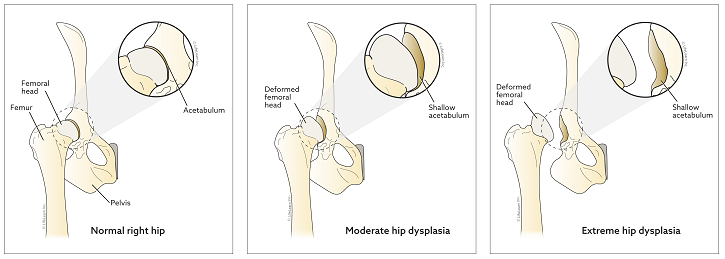Hip Dysplasia
What is hip dysplasia?
Hip dysplasia is a deformity of the hip that occurs during growth. The hip joint is a ball and socket joint. During growth, both the ball (the head of the femur, or thighbone) and the socket in the pelvis (acetabulum) must grow at equal rates.
In hip dysplasia, this uniform growth during puppy hood does not occur resulting in joint laxity followed by degenerative joint disease (DJD) or osteoarthritis (OA).
The degree of lameness that occurs is dependent on the extent of these arthritic changes and may not be correlated with the appearance of the hip joint on X-rays. Some pets with significant signs of hip dysplasia or osteoarthritis on X-rays may not exhibit any clinical signs, while others with minimal changes may experience severe pain and lameness.
What causes it?
Hip dysplasia is a genetic disease that is affected by factors such as diet, environment, exercise, growth rate, muscle mass, and hormones. As this disease is most commonly seen in large breed dogs (generally greater than 22 kg), these puppies should be kept at a normal, lean weight during growth, rather than overfed and encouraged to grow "big."
One study of puppies at-risk for hip dysplasia found that when fed as much as they wanted to eat, two-thirds of the puppies went on to develop hip dysplasia, while only one-third of puppies fed measured meals suffered from hip dysplasia. A study of German Shepherds found that overweight puppies were almost twice as likely to develop hip dysplasia as their normal-weight counterparts. These studies have allowed food manufacturers to develop specially formulated diets for large breed puppies.
If it is hereditary, are certain breeds affected more than others?
Yes, although any dog can be affected, it is predominantly seen in larger dogs such as German Shepherds, Saint Bernards, Labrador Retrievers, Golden Retrievers, Old English Sheepdogs, and Bulldogs. Large mixed-breed dogs are also at risk for developing hip dysplasia and should be fed a special large breed growth diet their first year.What symptoms should I look for?
Weakness and pain in the hind legs are the usual clinical signs. The dog appears wobbly and is reluctant to rise from a sitting or lying position. Some dogs will limp or be reluctant to climb stairs. These signs can be seen in puppies as early as a few months old but are most common in dogs one to two years of age. Dogs with mild hip dysplasia on radiographs (X-rays) may develop minimal arthritis without clinical signs until they are older. In fact, although hip dysplasia begins in puppyhood, most dogs do not develop clinical signs until they are older. It often takes years of gradual bone degeneration until a dog becomes symptomatic.
How is it diagnosed?
A hip radiograph under general anesthetic is the preferred method for diagnosing hip dysplasia. Clinical signs and palpable joint laxity may also indicate hip dysplasia. Any pet suspected of having hip dysplasia should be radiographed as soon as possible.What is the treatment?
Treatment depends upon the pet's clinical signs and amount of discomfort. There are very effective non-steroidal anti-inflammatory drugs (NSAIDs) (e.g., meloxicam) that have minimal side effects. The choice of medication is made on an individual basis, and various drugs may be tried before finding the most effective one.
Most dogs with hip dysplasia should receive veterinary-approved glucosamine, chondroitin sulfate, and omega-3 fatty acid nutritional supplements. Many dogs with painful hip dysplasia will benefit from polysulfated glycosaminoglycan injections on a regular basis. Moderate daily exercise, avoiding high impact activities such as jumping, may help keep the patient mobile and strengthen surrounding support structures.
Physical therapy has been demonstrated to be highly effective at improving an affected dog's quality of life and should be part of any treatment regimen. Since excess weight puts undue stress on the hip joints, weight loss is strongly recommended in overweight dogs.



